It’s winter in Maryland. In fact, it’s so much winter I shoveled 10 inches of snow off my driveway this morning. Fortunately, I had company. It wasn’t the kind of company that picks up a shovel and helps out, but still, the American robins darting back and forth over my head were still welcome (if surprising and surprisingly quiet) snow day companions.
Become a Member
Make a lasting impact for nature when you join The Nature Conservancy
“You know,” I said to them as I leaned on my shovel to watch about 25 birds flock together in my neighbor’s oak. “I think y’all are a little early—aren’t you supposed to be the first harbingers of spring?”
We’re not even a month past the first day of winter in the northern hemisphere. Spring is definitely not here. So why are the robins? Shouldn’t they be sunning themselves in warmer climes?
The short answer: as long as there’s food, American robins—true to their name Turdus migratorius (“the wandering thrush”)—kind of spend their winters coming and going as they please.
Robin Migration (AKA Robin Wandering)
Robins do migrate—but they don’t necessarily follow a more or less straight line from north to south in the fall, then repeat the journey south to north in the spring. In the fall and winter, when the ground freezes, robins lose access to their meal of choice: worms, insects (adult and larval) and (occasionally) snails. That’s when they turn to their winter diet staple: mostly fruit, mostly berries.
The folks at Journey North, a project tracking robin movements run by the University of Wisconsin-Madison, put it this way, “Some robins retreat all the way to southern Texas and Florida (in fact, some of the largest winter flocks documented by the Christmas Bird Count gather in sunny St. Petersburg, Florida), but others winter as far north as they can find berries. So they have an enormous winter range. Robins do migrate, but it has more to do with food sources than with being faithful to the same places year over year.”
In that way American robins are somewhat akin to teenage boys—they tend to go where the best (or most abundant or most easily accessible) food is, stay until it’s depleted, and then move on.
So as long as there are enough berries and other fruits to sustain them, you may see robins off and on throughout the winter across much of North America.
Forget the birdseed though. Robins’ digestive systems, unlike sparrows or other so-called feeder birds, aren’t built for dealing with seed, and their beaks aren’t built for cracking things open. Robin beaks are built for snapping up worms, catching insects, and plucking berries and other fruits. In the winter, a flock of robins can strip a holly bush with impressive speed and efficiency, and very little—if any—violent robin-on-robin aggression.
Food is also one of the reasons that robins, notoriously territorial and aggressive in breeding season, tend to gather and travel in flocks in the fall and winter. Numbers are good for defense, and also for spotting food—if one robin happens on a holly tree full of bright, ripe berries, the whole flock can partake. And then move on.
The tendency of robins to flock in winter may also be one of the reasons people seem to notice them—birds in large numbers tend to stand out when they’re gathered in leafless trees. (That and the beautiful red breast that is sometimes the only splash of color in a winter landscape that looks practically lunar in relentless shades of February white and gray.)
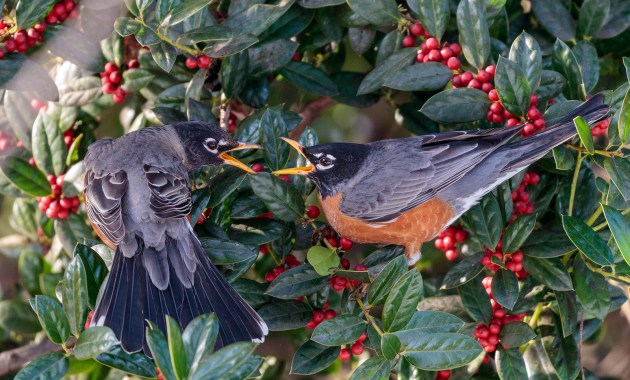
How do Robins Survive the Cold?
Robins are outfitted to survive huge temperature variances. In fact, hot weather seems to stress them more than cold.
If an American robin is healthy, has enough to eat, and is able to main its feathers, the temperature next to its body stays around 104 F—regardless of how cold it is in the world outside. It really is all about those feathers. (And the legs and feet.)
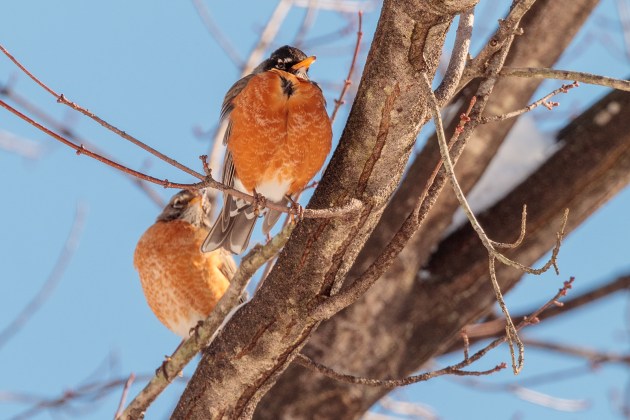
Robins, like most birds, have layers of feathers that perform different functions. When temperatures drop, robins puff the fine, downy feathers closest to their bodies to keep heat in, cold out. The outer feathers act like a kind of overcoat, shedding water and moisture and helping to regulate the bird’s temperature. (It’s an adaptation not limited to robins. Most birds with down feathers fluff them to regulate body heat).
The anatomy of a robin’s (and other bird species) also contributes to their cold adaptations. The bird experts over at the Cornell Lab explain it very well. The simplified version is that “most birds don’t succumb to frostbite because there is so little fluid in the cells of their feet, and their feet are mostly tendons and bones with little muscle or nerve tissue.”
So while blood does flow to their legs and feet, most birds (including robins) benefit from a very fast circulatory system and a “countercurrent heat exchange system.” Because bird legs are thin, the vessels that move blood from the heart to the feet and back again are very close together. That proximity means, per Cornell, “blood flowing back to the body is warmed by blood flowing to the feet. The newly cooled blood in the feet lowers heat loss from the feet, and the warmed blood flowing back into the body prevents the bird from becoming chilled.”
Robins: The Tell-Tale Birds of Spring
If robins are around in winter, why have they always been associated with the beginning of spring in the U.S.? Most likely it has to do with ground thaw, snow melt, and territorial behaviors like singing, worm hunting and nest building. But mostly, it’s the singing.
According to Journey North, which has a fantastic Q+A section I highly recommend for the robin-curious, “the robin’s song remains a reliable indicator that the first wave of spring migration has reached you. This song is one of the first signs that robins are switching from winter behavior to courtship and nesting behaviors associated with spring.”
Robins tend to move north as the ground thaws. The availability of high protein prey, especially worms that emerge with warmer, often wetter weather, is when a robin’s thoughts turn to procreation. And that’s the end of the cooperative fall and winter behaviors.
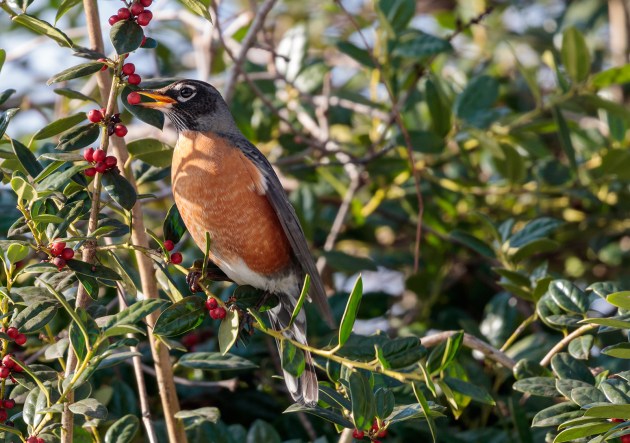
Which is one of the reasons many robins (primarily males) may stay through harsher winters instead of booking it to St. Petersburg: first access to the choicest nesting grounds. Breeding season is when robins also become more visible with mating displays, nest-building and a lot of time on the ground hunting for the tastiest worms. Until then, they’re all about the berries.
You Can Help Robins with Science from Your Own Backyard
Like many species, including other birds, scientists are starting to see some changes in robin behavior that is likely attributable to climate change. One study of American robins migrating to and from Canada’s boreal forest, showed that they’re beginning to journey south on average about 12 days earlier than in past years, or five days earlier per decade since 1994.
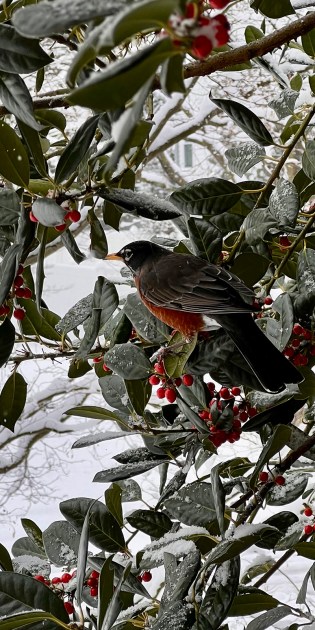
If you want to help scientists studying birds, there are several ways to contribute your observations (not just for robins, but for many of the species you can see outside your windows).
Journey North
You can submit your robin observations directly on the Journey North site (and check out their other migration-related citizen science projects). They also have 2025 maps tracking sightings so you can see where American robins (and other signs of spring) are being observed and follow along (and contribute to) the wanderings of Turdus migratorius.
Cornell Lab of Ornithology
The Cornell Lab has a number of different ways you can contribute to science for birds. Your sightings tracked on eBird (free) contribute to worldwide data for birding, science, and conservation. Want to know what birds are being seen in your neighborhood, eBird has a feature for that. If you’re new to birding, check out their genius birding ID app, Merlin.
You can also contribute to Project FeederWatch (requires subscription) by counting birds at your feeder from November through April. Your observations help scientists monitor changes in the abundance and distribution of birds, including the influence of changes in habitat, disease, and climate.
And mark your calendars for the 2025 Great Backyard Bird Count (February 14-17). Spend time in your favorite places watching birds—then report them to Cornell! It’s easy to participate, “in as little as 15 minutes notice the birds around you. Identify them, count them, and submit your counts to help scientists better understand and protect birds around the world. You can see the results from 2024 here.
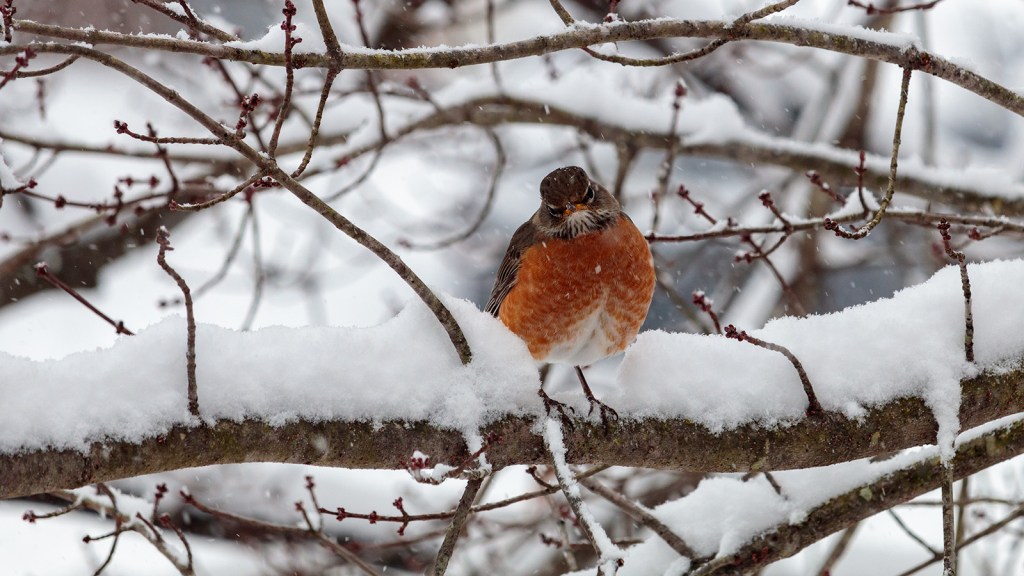



2/20/2021, Abilene Tx. I had 6 robins in the yard today. 24” of snow had melted and grounds saturated. Went to the door and there they were digging in the ground. Took photo but opening the door scared then so I threw bread. Other birds came not the robins. Then I read the article that they do worms. Learned a lot from the read.
Thank you! We found this article most enjoyable and informative, as we have seen “big, fluffy” robins in our yard this week (earlier than we’ve ever remembered), feasting on the red berries from our barberry and holly bushes …in the coldest temps. and most snow accumulations we’ve had all winter, in northern Indiana!
Many questions have been answered. I love feeding birds and taking pictures of them. I will start setting up a water source for. Thanks again.
I live in Crosby, TX. Before February 14th the robins were everywhere. They were here during the cold blast this week but boy did I see them in the yard again today. It was in the 50s instead of the 20s. This is more than I’ve seen since I moved here in 2016. I’ll definitely keep my eyes out for other signs.
After several days of snow and temps in the teens, snow started to melt. Today is 4th day we’ve had a huge flock of robins eating under our cedar tree .Seldom even see one robin here in SW Oklahoma pastureland.
Does the male being territorial explain why the robin throws itself at its reflection in my windows… a habit difficult to discourage?
I’ve seen what I think is the same robin at my feeding station in Columbus, Ohio, for the past three weeks or so. I thought it was a female, but now realize it was a male with his feathers all fluffed out. We had single digit morning temps this week, but the robin was here every day. (Also have recognized a cardinal pair, lots of finches and sparrows, some starlings and crows, and a couple of big bluejays. My squirrels are happy, too.)
Yes! I was surprised to see them in cold, snowy Michigan!
Hundreds of male robins here in Lakeway ,tx now. Waxwings as well.
We live in upstate New York, in the Town of Richmondville, NY. We had a flock of robins in our backyard over a week ago . ( Mid February 2021) . I heard them before I saw them . They were around for a few days eating berries off our crab apple trees. They were a sight to see/hear!
When I was teaching in Munising, Michigan a pair of robins built their nest on the window cell under a huge pine tree right outside my bedroom window. I drew the shade to give them privacy but checked on them from time to time. One day the eggs began to hatch. I brought my class of 10 year olds through the convent and we all silently watch the newly hatched babies being care for by their parents. We made several trips to see the progress of the birds as the little ones grew and finally flew away. . That was in 1959 yet the memory if still fresh. Sister Noella McLeod., OP
Saw a small flock on my country Rd here in Southern N.Y.
Also, heard one in my yard singing, but couldn’t get my eye on him.
We’ve always had robins, but this is the first time I’ve seen any in early February.
Irving, TX – spotted about 20 Robins feeding off of berries in my neighbors yard. Snow and single digit temperatures. This was a first time observation. A most beautiful and surprising event. I captured video from a second story window.
Large flocks of robins have been seen this week in Burleson, Tx area. I had not seen robins in large groups like this except when we had figs on the ground in the summer. They didn’t stay long at my house but others have reported them feeding on berries for a day or two.
I live in Dallas, Texas, and right in the path of the storms that caught Texas off guard. After three days of power outages and freezing in the dark, the fourth day — which was Thursday, February 18th — brought temperatures into the 30-degree range. The first joyful sight I had was observing at least 100 or more Robins eating the fruit from the trees in my yard and my neighbors’ yards! It was beautiful. One of my fruited trees is right outside my window in one of my rooms. I sat there watching the Robins for almost a half an hour. Prior to the Robins’ arrival, my tree was beautiful and full with red berries. Knowing the birds were getting nourishment from my trees made me so happy! And now my trees are just green. Oh, well. But your article answered the question in my mind of how can they withstand such freezing cold temperatures! Oh, they were also lined up across mine and my neighbor’s roof drinking the water that was melting from all the icicles. It was fascinating and beautiful.